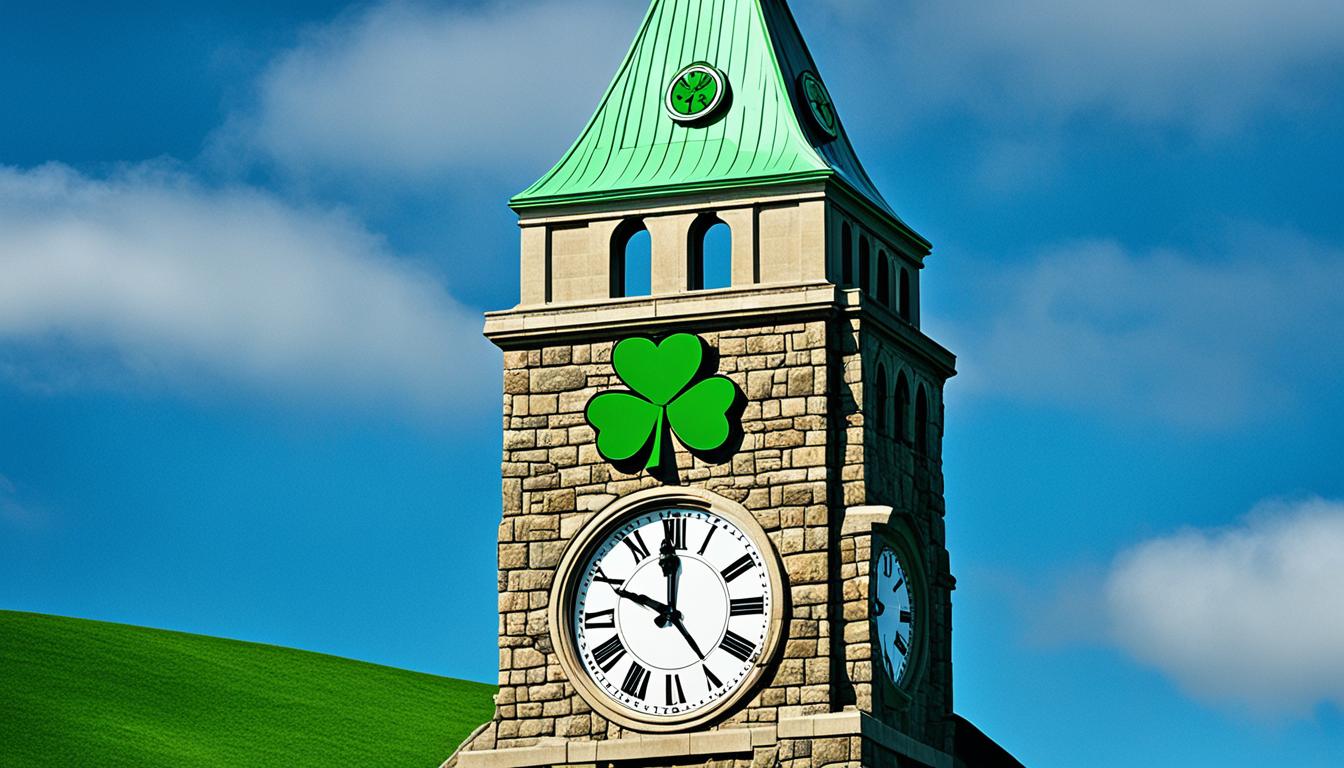For over three decades, Ireland had its own time zone called Irish Standard Time (IST). This time zone was UTC+01:00 in summer and UTC+00:00 in winter. Ireland’s location played a big role in this choice, with most of the country west of the 7.5°W meridian. This meant local time was closer to UTC-01:00 than GMT.
The Irish Standard Time was made official by the Standard Time Act 1968. It said the time in Ireland would be one hour ahead of Greenwich Mean Time all year. Later, the Standard Time (Amendment) Act 1971 changed this, making Greenwich Mean Time the winter time. So, Ireland was one hour behind its standard time in winter and back to standard in summer. This made Ireland stand out and added an interesting chapter to timekeeping history.
Key Takeaways
- Ireland used its own time zone, Irish Standard Time (IST), for over three decades.
- IST was UTC+01:00 in the summer and UTC+00:00 (Greenwich Mean Time) in the winter.
- The Standard Time Act 1968 legally established IST, while the Standard Time (Amendment) Act 1971 introduced GMT as the winter time period.
- Ireland’s geographical location, with most of the country west of the 7.5°W meridian, influenced the adoption of this unique time zone.
- During the winter months, Ireland operated one hour behind its statutory standard time, reverting to standard time in the summer.
History of Time in Ireland
Ireland’s history with time is quite interesting, covering many centuries. Before 1880, Ireland followed local mean time, part of the UK. The Statutes (Definition of Time) Act of 1880 changed this by making Dublin Mean Time the official time. This time zone was about 25 minutes and 21 seconds behind Greenwich Mean Time (GMT).
The Dunsink Observatory near Dublin was key in setting Dublin Mean Time. Astronomers there made sure the time was accurate. The Easter Rising of 1916 changed Ireland’s timekeeping. The Time (Ireland) Act of 1916 made Irish time the same as British time from October 1, 1916, at 2:00 am Dublin Mean Time.
After Ireland became the Irish Free State in 1922, it kept the UK’s timekeeping ways. This was to keep things consistent with Northern Ireland, which stayed with the UK. In the late 1960s, Ireland was getting ready to join the European Economic Community (EEC). From 1968 to 1971, it tried standard time (GMT+01:00) for a year. This showed Ireland’s readiness to match its European neighbors.
Ireland’s Unique Time Zone
Ireland has its own time zone, making it stand out in Europe. In summer, it follows Irish Standard Time (IST, UTC+01:00). In winter, it goes to Greenwich Mean Time (UTC+00:00). This is different from most European Union countries, which move their clocks forward in summer.
But, Ireland ends up in the same time zone as Portugal and the UK. This means Ireland’s time matches theirs.

The switch to and from daylight saving time, or Irish Summer Time, happens at the same time across Europe. In Ireland, clocks go back to 01:00 GMT on the last Sunday in October. They move forward to 02:00 IST on the last Sunday in March.
This makes Ireland the same time zone as the UK and Portugal, known as Western European Time. Ireland’s daylight saving time is a bit different from other EU countries. But, it keeps Ireland in line with its European neighbors. This helps with easy communication and trade across time zones in Europe.
Synchronization with the European Union
Since the 1980s, the European Union has made sure all its member states switch between winter and summer time at the same time. On 8 February 2018, the European Parliament voted to review the Summer Time rule in Europe. This move came after a web survey showed many people wanted to stop changing clocks twice a year.
The European Commission then decided to suggest ending seasonal clock changes. They wanted to repeal Directive 2000/84/EC. For this idea to happen, it needs approval from the European Union’s Council and Parliament.
By September 2018, the UK Government said it had no plans to stop daylight saving. In Ireland, the Department of Justice and Equality consulted the public on seasonal clock changes in November 2018.
For a long time, the European Union has kept time changes the same across all states. This was to avoid confusion and make things simpler for everyone. But now, there’s talk of possibly ending seasonal clock changes. This has started a new debate on how the EU will manage time in the future.
Potential Changes to Ireland’s Time Zone
The future of Ireland’s time zone is up for debate. In July 2019, the Minister for Justice and Equality said ending daylight saving time was not easy. An opinion poll showed 82% of people didn’t want different time zones in Ireland and Northern Ireland.
The Justice Department released a report on the topic. They also shared public feedback on changing clocks with the seasons.
MEP Seán Kelly wants to stop the clock change in the EU. He suggests Ireland could stay on summer time all year or switch to Central European Time. This idea could affect the Irish border, as Northern Ireland might be on a different time than the rest of Ireland or the UK during some months.
The Irish government is thinking about these changes carefully. They will look at what people think, how it affects the economy, and how it impacts cross-border activities. The decisions made will influence Ireland’s time-keeping for a long time.

Leave a Reply